MCHE leader explains the origins of the two commemorations that fall within weeks of one another
As a community, we gather twice a year to remember those lost in the Holocaust and to pay tribute to those who survived. Though similar in their desire to honor and commemorate, the origins of Yom Hashoah and International Holocaust Remembrance Day reflect different goals.
Yom Hashoah
Yom Hashoah is an Israeli, and specifically Jewish, recognition of the Holocaust. Discussions about how to appropriately commemorate the Holocaust have occurred since the very early days of post-liberation in 1945. The first conversations were held amongst the survivors themselves and centered on dates commemorating the experiences of the Warsaw Jewish community — the largest in Europe.
On December 28, 1949, the first Holocaust Remembrance Day took place in Israel with the re-interment of Jewish remains moved from the Flossenbürg camp near Munich to a crypt in a Jerusalem cemetery. From that first observation, other Israeli commemorations periodically occurred, though there was no consensus on which date to commemorate.
In 1951, the Knesset designated the 27th day of Nisan as Holocaust Remembrance Day. The date was chosen to coincide with the anniversary of the Warsaw Ghetto Uprising and the name —Yom Hashoah Ve-Hagevurah (Day of (Remembrance of) the Holocaust and the Heroism) — pays tribute to those lost in the Holocaust and to the heroism of the European Jews. This was codified in Israeli law on March 4, 1959.
American Jewish communities soon began holding Yom Hashoah ceremonies. In Kansas City, the ceremony was initiated by survivors who met with Sol E. Margolin, executive director of the Jewish Community Center, to consider ways to commemorate the Holocaust. This meeting led to the formation of what they would call “The New Americans Club of the Jewish Community Center of Kansas City.”
The following year, in 1959, two significant memorial projects emerged: the annual Yom Hashoah service, which the New Americans called the Warsaw Ghetto Memorial Service, and the Warsaw Ghetto Monument, which the New Americans named the Memorial to the Six Million. Today our local Yom Hashoah commemoration follows the format established by the survivors themselves.
International Holocaust Remembrance Day
In contrast to Yom Hashoah, International Holocaust Remembrance Day (IHRD) was conceived as an international recognition of the Holocaust. The resolution was introduced by the Israeli delegation and unanimously passed by the General Assembly as UN Resolution 60/7 on November 1, 2005. It established January 27 as IHRD, the anniversary of the liberation of Auschwitz by the Red Army in 1945 — signifying the status of Auschwitz as the international symbol of the Holocaust.
As part of the goal of this resolution, the UN urges every member state to honor the six million Jewish victims of the Holocaust and millions of other victims of Nazism on this date. It further encourages the development of educational programs to help prevent future genocides and explicitly rejects Holocaust denial and revisionism.

Locally, MCHE emphasizes the educational aspect of this mandate in our community commemoration. For the past several years, we have hosted noted scholars to teach our community about important aspects of the Holocaust and important research initiatives which further the goal of establishing evidence of the Holocaust.
Yom Hashoah 2021
The community is invited to share in the 2021 virtual Yom Hashoah ceremony, which will begin at 1:30 pm on April 11. This year’s ceremony commemorates the 78th anniversary of the Warsaw Ghetto Uprising and the 58th anniversary of the dedication of the Memorial to the Six Million.
Along with MCHE, organizers of the event include JCRB | AJC and the Jewish Community Center.
In addition to the traditional lighting of 6 candles recognizing the 6 million Jewish victims, the program features Ida Kolkin, daughter of Holocaust survivors Maria and Fred Devinki, both of blessed memory, sharing the experiences of her parents’ survival by hiding near Wodzisław, Poland. Rabbi Moshe Grusgott of Kehilath Israel Synagogue will offer opening remarks and Rabbi Doug Alpert of Congregation Kol Ami will offer closing reflections and recite Kaddish.
Registration for the Zoom is required at www.mchekc.org/yomhashoah. The video of the commemoration will be available in the days following at www.mchekc.org.
The following organizations sponsored this year’s Yom Hashoa ceremony: Congregation Beth Shalom, Congregation Beth Torah, Congregation BIAV, Congregation Kol Ami, Congregation Ohev Sholom, Congregation Ohev Sholom Sisterhood, Hadassah Greater Kansas City, Jewish Community Center of Greater Kansas City, Jewish Community Foundation of Greater Kansas City, Jewish Community Relations Bureau/AJC, Jewish Family Services, Jewish Federation of Greater Kansas City, Jewish Vocation Services, Jewish War Veterans Mo-Kan Post 605, Kehilath Israel Synagogue, Menorah Heritage Foundation, Menorah Medical Center, Midwest Center for Holocaust Education, National Council of Jewish Women, Rabbinical Association of Greater Kansas City, Temple Sinai, The New Reform Temple, The Temple, Congregation B’nai Jehudah Sisterhood, Village Shalom
Jessica Rockhold is executive director of the Midwest Center for Holocaust Education



